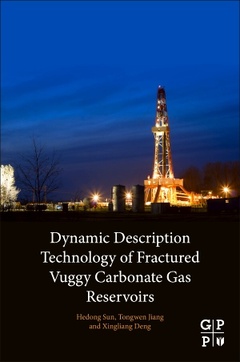Description
Dynamic Description Technology of Fractured Vuggy Carbonate Gas Reservoirs
Authors: Sun Hedong, Jiang Tongwen, Deng Xingliang
Language: English
Subject for Dynamic Description Technology of Fractured Vuggy...:
Keywords
Gas reservoir; carbonate reservoirs; vugs; well production; dynamic monitoring of gas; wellbore node analysis; production log analysis; wireline formation test; well test analysis; production decline analysis; dual-porosity; double fracture; multi-well test; production data; bottom hole flow; well performance forecasting; dynamic reservoir model; vug reservoir; reserves; material balance analysis; water-drive gas; ultra-high pressure; flowing material balance; recoverable reserve estimation; PVT data; gas-liquid
187.99 €
In Print (Delivery period: 14 days).
Add to cart367 p. · 15x22.8 cm · Paperback
Description
/li>Contents
/li>Biography
/li>Comment
/li>
Dynamic Description Technology of Fractured Vuggy Carbonate Gas Reservoirs delivers a critical reference to reservoir and production engineers on the basic characteristics of fractured vuggy gas reservoirs, combining both static and dynamic data to improve reservoir characterization accuracy and development. Based on the full lifecycle of well testing and advanced production decline analysis, this reference also details how to apply reservoir dynamic evaluation and reserve estimation and performance forecasting. Offering one collective location for the latest research on fractured gas reservoirs, this reference also covers physical models, analysis examples, and processes, 3D numerical well test technology, and deconvolution technology of production decline analysis.
Packed with many calculation examples and more than 100 case studies, this book gives engineers a strong tool to further exploit these complex assets.
1. Typical characteristics of fractured vuggy carbonate gas reservoirs2. Overview of the dynamic description technology and dynamic monitoring of gas reservoirs3. Well test analysis method of fractured vuggy carbonate gas reservoir4. Reserves estimation method of fractured vuggy carbonate gas reservoir5. Performance forecasting method of fractured vuggy carbonate gas reservoir
Appendix1. Nomenclature2. Unit Conversions from SI to Other Unit Systems3. Common Formulas for Gas Flow in Porous Media4. Foundation of Gas-Liquid Two-phase Flow in Porous Media
Tongwen Jiang, PhD is an engineer and earned his PhD degree in oil & gas field development engineering from Southwest Petroleum Institute in 1996.He began working for Tarim Oilfield Company in 1996, and he has deep experience in reservoir studies and management. He has published over 30 papers about complex oil & gas reservoir studies such as condensate gas reservoirs and fractured reservoirs. He is an author of 4 books and an active member of the Society of Petroleum Engineer and the American Association of Petroleum Geologists.
Xingliang Deng, PhD is a senior engineer at the Research Institute of Petroleum Exploration & Development of the Tarim oilfield. Since he graduated from China University of Petroleum in 1992, he worked in the Tarim oilfield and specialized in reservoir description, well position deployment and development programs for fractured-vuggy carbonate reservoirs, such as Tazhong1, Lungu, Halahatang and the Yingmaili reservoir. He holds a BS degree in petroleum and natural gas geological exploration technology from China University of Petroleum, and a PhD degree in Petroleum Geology from Nanjing University. He has published over 40 papers in peer-reviewed journals and conferences. He is an author of one book published and an active me
- Presents advanced knowledge in well test and production decline analysis, along with performance forecasting that is specific to fractured vuggy carbonate gas reservoirs
- Helps readers understand the characteristics, advantages, disadvantages and current limitations in technology of fractured vuggy carbonate gas reservoirs
- Provides a bridge from theory to practice by combining static and dynamic data to form more accurate real-world analysis and modeling




